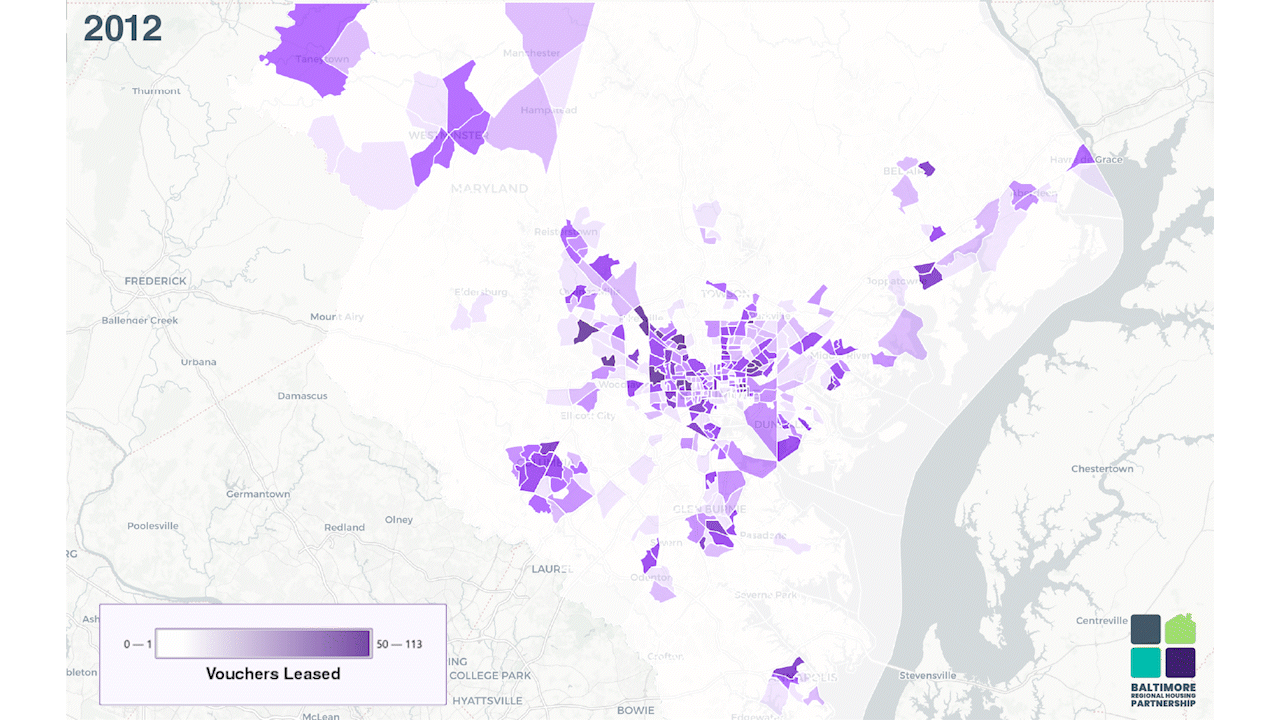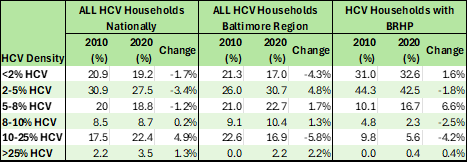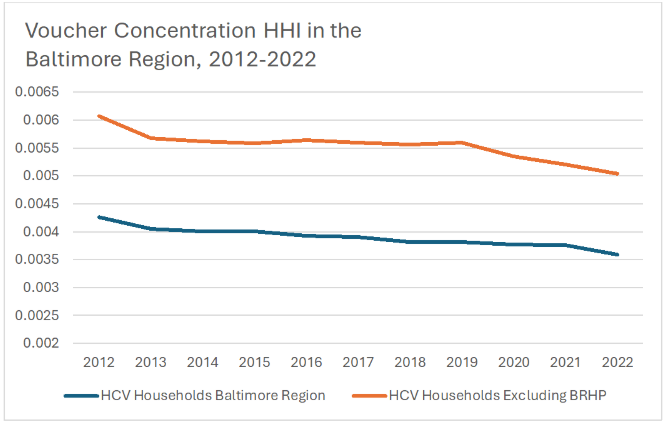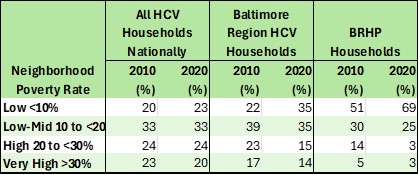
2012 & 2022
The Housing and Community Development Act of 1974, which created the first Tenant Based Rental Assistance program called the Housing Choice Voucher (HCV) program, had as one of its goals “the reduction of the isolation of income groups within communities and geographical areas and the promotion of an increase in the diversity and vitality of neighborhoods through the spatial deconcentration of housing opportunities for persons of lower income…”. Housing Choice Vouchers are tenant-based, portable subsidies that low-income families can use toward their rents in the private market. In order to be eligible, a family must be very low-income (50% or below area median income (AMI)), although 75% of all vouchers must be given to extremely low-income families (30% or below AMI). Households generally pay 30% of their income towards the rent, and the voucher covers the remaining portion. Since its introduction in the Nixon administration, the Act has created the Federal Government’s most significant tool to address a host of issues, including housing affordability, quality, and stability. However, more than five decades since, the Housing Choice Voucher program has yet to realize its full potential to truly unlock choice for the more than 2 million recipients.
A recent article in Cityscape journal’s “Fifty Years of Tenant-Based Rental Assistance” edition entitled “Location Patterns of Housing Choice Voucher Households Between 2010 and 2020,” evaluated the more recent years of the program in terms of the goal of spatial deconcentration. The article highlights the fact that concentration of voucher households has increased nationally in the decade between 2010 and 2020. However, the article reports that during that timeframe the greatest decrease in voucher concentration by metropolitan area occurred in the Baltimore-Columbia-Towson Metropolitan Statistical Area (MSA). This is a significant accomplishment for our region that stands in contrast to the national trend.
What has the Baltimore region done during this period to achieve voucher deconcentration and expand housing choice when so much of the country is experiencing greater concentration?
Operating since 2002 in the Baltimore region[1], the Baltimore Housing Mobility Program has played a pivotal role in this success. Following the final Settlement Agreement of the Thompson v. HUD lawsuit in 2012, the Baltimore Regional Housing Partnership was created to administer the program and lead a period of significant growth. In 2012, the program was serving just under 1,800 households, and by the start of 2019, that number ballooned to nearly 4,400 households.
BRHP’s program is explicitly designed to promote geographic mobility for households with voucher assistance, coupling rental assistance with pre-and post-move counseling support to empower moves to low-poverty neighborhoods deemed by the program to be “opportunity” areas, which are designated by analysis of statistical metrics like poverty rate, unemployment rate, median household income, and other quantifiable metrics demonstrating community, educational and career opportunities. While the Baltimore region enjoys some of the highest median household incomes in the country, significantly above the national average of $80,610, (average median incomes: $87,056 in Baltimore County, $141,159 in Howard County, $117,650 in Anne Arundel, $105,029 in Harford County and $114,974 in Carroll County), families with limited incomes searching for housing in the private market often cannot access these opportunities without the support of dedicated housing mobility efforts.
The success of BRHP participants in accessing these neighborhoods has had a direct impact on voucher concentration in the region and has made Baltimore an exemplar for unlocking the promise of the housing choice voucher to create pathways to economic opportunity that can lead to achievement of the American Dream.
Density of Housing Choice Vouchers
The article uses several methods for measuring voucher concentration. The first looks at the density of voucher in census tracts and measures a region’s distribution of voucher households relative to that density. The data show that nationally, there is a “trend toward an increasing share of voucher households living in HCV-dense areas.” As you will see in Figure 1, the Baltimore Region is generally consistent with this trend, however, the BRHP households in the region increased in the least dense neighborhoods, and overall BRHP households are far more likely to be in the least dense HCV neighborhoods, with fully three quarters of BRHP households living in neighborhoods with less than 5% HCV households.

Voucher HHI Index
The Herfindahl–Hirschman Index is a commonly accepted measure of market concentration2, most often used to measure the extent to which a particular firm has monopolized an industry. In this context, the HHI “was used to understand the magnitude to which TBV [Tenant-Based Voucher] households concentrated in a few neighborhoods…”; using such an index allows for a standardized measure that can be analyzed across time and metropolitan areas.
As previously mentioned, for the period from 2010 to 2020, the Baltimore region saw the largest decrease in voucher concentration as measured by the HHI across the nation.
Using 2012 as the baseline date for Figure 2 below, which coincides with period immediately before the significant growth of the BRHP program, the HHI score for all voucher households is 0.00426; however, excluding the BRHP households from the calculation the HHI is significantly higher, at 0.00607. Throughout the period of 2012-2022, BRHP voucher households had a significant effect on reducing voucher concentration as measured by HHI, accounting for a reduction of between 28-32%.

Poverty Rates of Neighborhoods with Vouchers
A persistent concern of policy makers and voucher administrators has been the poverty rate of neighborhoods where vouchers are used. While some gains were made in lower poverty neighborhoods in the decade from 2010 to 2020, a large portion of the HCV program remains concentrated in high poverty neighborhoods. In 2020, 44% of voucher households lived in high poverty neighborhoods with a 20% poverty rate or greater.
In Figure 3 below, the scale of the effectiveness of housing mobility programs comes clearly into view, showing how successful BRHP households are at accessing rental housing in low-poverty neighborhoods. While the Baltimore region’s voucher households closely followed the national poverty distribution in 2010, the growth of the BRHP program significantly improved the region’s numbers overall – going from only 22% in low-poverty neighborhoods in 2010 to 35% in those neighborhoods by 2020. In 2020, only 23% of all HCV households nationwide and 35% of HCV households in the Baltimore Region were in low poverty neighborhoods. Comparatively, in 2020, 69% of BRHP’s nearly 4,400 households resided in low-poverty neighborhoods with poverty rates less than 10%, and only 6% in neighborhoods with poverty over 20%.

Conclusion
Housing mobility programs have repeatedly been shown to have drastic, positive effects for families who participate, generating significant improvements in health and long-term financial outcomes. Beyond the individual benefits, robust housing mobility programs operating at scale can drastically reduce the voucher concentration of a region as participants gain access to rental properties in more communities with greater opportunities. Housing mobility can fulfill the promise of the Housing Choice Voucher Program, advancing economic and racial integration and serving as a powerful tool to reduce poverty concentration while expanding a renter’s choice.
Written by: Pete Cimbolic, Managing Director of Research and Innovation; Graham Bos, Data & Innovation Supervisor; Henry Podeschi, Data Analyst; Chandra Tamang, Data Analyst
1 The Baltimore region in the context of BRHP and the Baltimore Housing Mobility Program encompasses Baltimore City, and Anne Arundel, Baltimore, Carroll, Harford and Howard counties.
2 www.justice.gov/atr/herfindahl-hirschman-index

Jessica Baskerville joined BRHP as a communications and special projects intern for the summer. In this Q&A, Jessica shares why she joined our team, what she’s been working on, and what she’ll take away from her time with us.
Can you share a little bit about yourself and why you chose the Baltimore Regional Housing Partnership for your internship?
I’m a rising senior at the George Washington University in Washington, D.C. I’ve spent the past three years studying journalism, communications and criminal justice while interning for different organizations in the DMV. Through living in D.C. and watching the COVID-19 pandemic impact every aspect of life as we know it, I learned a lot about how housing stability is linked to public health, racial disparities, economic disparities, and educational stabilities. During this time, I found this BRHP internship on Handshake. I really wanted to get involved in more advocacy and issue-focused work, and the mission and work of BRHP called out to me.
What have you been working on during your internship?
Every month, I drafted content for the social media calendar for Twitter, Facebook and Instagram. I created graphics and posts to educate our families about the children tax credit, BRHP’s office reopening, adult education opportunities, and financial literacy. For some of our virtual events, I worked on the outreach and created scripts and presentations. For our Back to School Supply Drive, I worked with Senior Communications Manager Tiffani Long to create a timeline, reach out to libraries and community centers, coordinate with our families and pack the school supply bundles to help our families prepare for the school year. I also wrote a blog about how our property partners can promote housing stability by helping their tenants find rental assistance.
How do you think you’ve helped our team with its mission?
Through the instability of the COVID-19 pandemic, I’ve been able to help BRHP’s mission by communicating concise and consistent information. By showcasing our resources, writing scripts for videos and presentations to inform our families and property partners and providing solutions, I’ve been able to provide information during a particularly chaotic time.
Did anything surprise you about working at BRHP?
I was surprised with just how many bases BRHP covers in their work. Not only does BRHP help families with housing vouchers find housing, but they also counsel them before, during, and after they move-in. They also focus on their property partners by making sure they maintain professional relationships with their tenants and have the resources to provide stable and safe housing for their families. They do this by hosting monthly property partner power hours on frequently asked questions, along with sending bi-monthly resource newsletters. It’s amazing to know that they’re able to provide relief in more ways than one.
What have you learned during this internship that you can apply in the future?
The best part about working at BRHP is that you get to see the direct impact of your work on the families in our program. With that mind, all skills are valued at places like BRHP, from counseling, to technology, to customer service; nonprofits are made up of so many amazing people with different backgrounds that are all working toward a common goal. I learned from my time at BRHP just how much I value making an impact through communications and outreach. After my time at BRHP, I’ll continue to advocate for increased access to stable housing. I’ll also definitely look at positions at nonprofit organizations after graduating from college.
BRHP is always seeking student interns. If you are interested in furthering our mission and being considered for a paid or school credit internship, please send your resume and cover letter to resumes@brhp.org.
With the ongoing COVID-19 pandemic, millions of Americans have been unable to pay their rent. This has not only caused distress amongst tenants that are working to make ends meet, but to the landlords that house them. While state and federal eviction moratoriums have allowed tenants to remain in their homes, many landlords are struggling to pay their expenses because their tenants are unable to pay rent. The Maryland eviction moratorium is set to end on August 15 and many Maryland renters are in jeopardy of being evicted. This reality is true in part because available resources are not being utilized by both tenants and landlords.
More proactive solutions for housing insecurity have been growing. The Housing Choice Voucher (HCV) program provides stability for participants as a housing subsidy can increase if a participant’s income decreases. President Biden has proposed a $9 billion increase in spending for the U.S. Department of Housing and Urban Development, which would go a long way towards ensuring housing security for families, specifically when facing economic hardships.
For short-term, emergency needs, legislation at the state and federal level has established several emergency rental assistance programs to keep renters housed and landlords financially stable. Times like this require an “all hands-on deck” approach from landlords, housing providers, and tenants. Here we will list a few steps our BRHP property partners can take to ensure housing stability for their tenants.
Use BRHP as a resource – we are here to help!
• Encourage your tenant to complete our Interim Change Packet to report any income losses. This is a BRHP program requirement and alerts us to make changes to your tenant’s rental portion to ensure you get paid.
• Maybe your tenant still hasn’t completed the Interim Change Packet to report their income loss and you’re missing your rent. No worries, you can complete our Non-Payment of Rent Report Form on our website. You should do this as soon as possible because it alerts our counseling team, so they can step in and address the situation.
• Would you like to schedule a mediation with our counselors directly? Call BRHP’s hotline at 667-207-2100 and ask to schedule a landlord-tenant mediation.

Share Maryland’s Emergency Rental Assistance Program with your tenant – you may be able to apply too!
In addition to using us as a resource, there is emergency rental assistance available throughout the state for your tenant (yes, they are eligible to apply!). This assistance became available in the spring of 2021 and the Maryland Department of Housing and Community Development lists all emergency rental assistance programs, application links, program status, and more by local jurisdiction. Some jurisdictions even allow landlords to apply on behalf of tenants. For example, Baltimore City has a program that work simplifies the application process for landlords and housing providers that have multiple tenants that are struggling to pay rent.
Trust us, we know that tenants aren’t the only ones struggling during this pandemic, property owners are too, and so we are making every effort to help. A BRHP, we are committed to the success of our families and property partners. That’s why we have a dedicated team of counselors, a landlord relationship specialist, and host special events like our monthly Property Partner Power Hours and enrichment webinars for our program participants. We need your support and commitment to keep our families housed during this public health crisis. By using the steps we’ve outlined above, we’re confident that you will get through this challenging financial time, while also keeping a family safely housed at a moment when it’s needed most.
Jessica Baskerville is BRHP’s Communications and Special Projects Intern
//